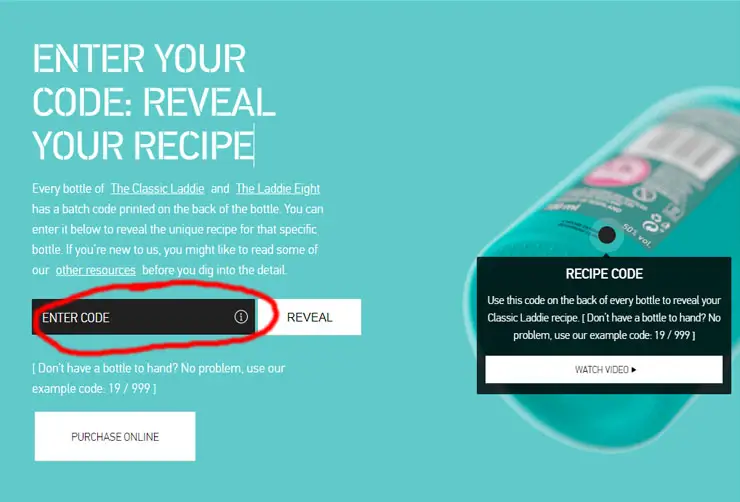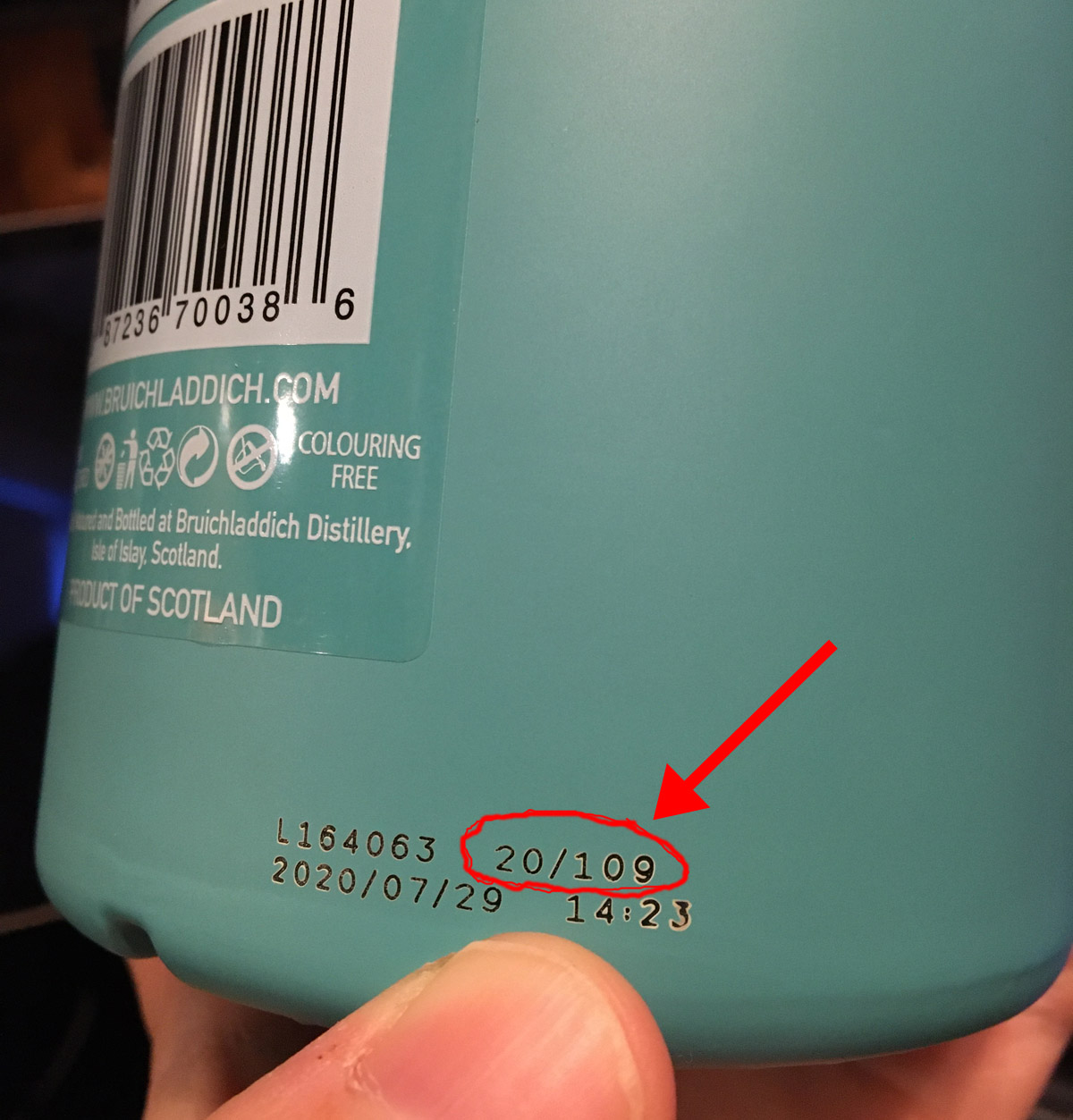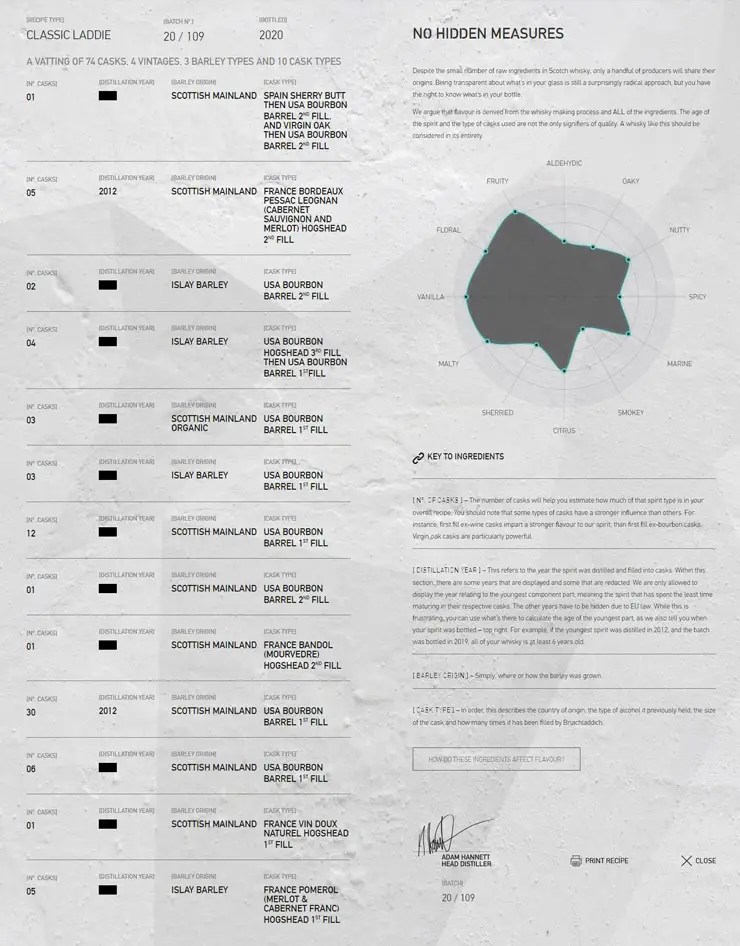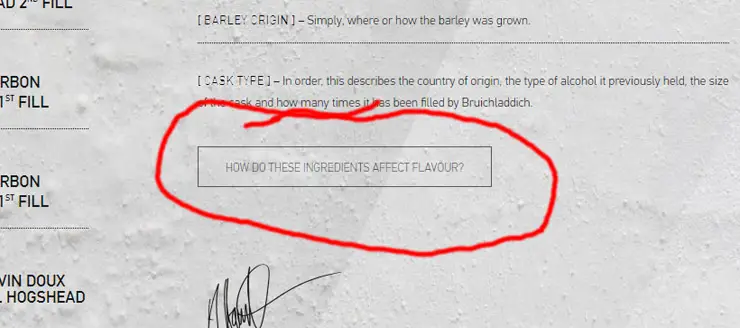And we’re back with another Bruichladdich post! This is becoming the all-Bruichladdich all-the-time blog lately. This time I was asked by the folks at the distillery to help spread the word about the latest phase of their Transparency Campaign. Yup, you might remember a few years ago I covered Compass Box’s Transparency Campaign. (For free, c’mon Compass Box!) If you were paying attention at the time, you know that Bruichladdich also jumped on board the transparency train by posting all of their recipes – meaning what barrels were vatted to make each release – on their website. Unfortunately due to SWA nannying and, well, UK law, they weren’t allowed to tell anyone about it.
This time around they’re doing it a little differently. All recipes for Classic Laddie and Laddie Eight batches are on the website, you just have to put in your bottle code (see below) to view them. Also, you don’t get to know the ages of the barrels except for the youngest ones, again due to UK law. Let’s walk through the process so you can see what transparent goodies are available. First, go to Bruichladdich’s website and navigate to the Transparency page. Scroll down to enter your code in the “Enter Code” box:

To find your bottling code, check the back of the bottle, way down at the bottom printed in nearly-transparent eensy teensy little numbers. If you don’t happen to have a bottle of Classic Laddie or The Laddie Eight around (note this works with old bottles too!), you can use my code: 20/109.


You will be presented with altogether more information than you asked for about how Bruichladdich put together your batch of The Classic Laddie. Before you go any further, note the black “redaction” boxes scattered around the page. These are the distillation year (thus: age) of each barrel that you’re not allowed to see. Why? Because they’re greater than the youngest one. Thanks, UK law. A little trick, though. Look at the top of the page and you’ll see something like “A VATTING OF 74 CASKS, 4 VINTAGES, 3 BARLEY TYPES AND 10 CASK TYPES”. Now that you know how many total vintages there are, and you know the youngest (in my case, bottling year 2020 minus distillation year 2012, round down for likely partial year: 7), you can make a Wildly Inaccurate Uneducated Guess about the possible ages of the other barrels. For mine, 7, 8, 9, 10? Maybe? You can get even more inaccurate and wild by taking the number of barrels on each row and calculating some averages. My bottle is 47.29% seven year-old whisky! I feel so enlightened.

Before you ask, the actual distillation year isn’t hidden behind those little black boxes in the HTML. I… well… I checked.
I was assured by Bruichladdich Distillery Brand Ambassador Raymond Tibbs that the barrels that go into the Classic aren’t solely the youngest available. They span anywhere from 5 years to 12 years of age, and are chosen based on Head Distiller Adam Hannett’s goals for that particular batch. You see, The Classic Laddie unlike other single malt flagship expressions is not designed to maintain unwavering consistency. Adam is always going for a general house character (unpeated, and “light, fruity, floral”) but allows the whims of the available casks to guide him in creating each batch with its own individuality. He’s looking for consistency of quality, not consistency for conformity’s sake. In the pursuit of these goals, the Classic Laddie often has some percentage (17.57% in my batch. Haha!) of wine-finished or wine-matured casks in it. Even more interesting, rows that show two or more different kinds of cask types (like row #1 on mine) are barrels that Adam re-casked mid-maturation in order to partially introduce flavors or develop different flavors. Some of these have as many as 4 or 5 different cask types! He calls these “building blocks” and it’s the kind of hands-on whisky production that makes me realize how difficult and nuanced the job really is.
This kind of transparency is great for the industry. It shows, for those who are interested, that young whisky is not necessarily inferior whisky. Age matters, yes, and we wish the UK would allow distillers to tell us consumers all of the age-related information about a NAS whisky, but what people don’t realize when they see that bottle label sans-age statement is that young whiskies show the character of the grain/distillate while old whiskies show the character of the oak. Some of the best whiskies come from combining these two facts. The thousand variables of oak maturation are so varied and unpredictable that you can’t assume only one of those variables (age) will have the greatest effect. For example, Adam tells a story about a cask of 1 year-old distillate in a first-fill ex-bourbon cask that he found in the warehouse which had already taken on so much oak character that it looked and tasted like a 10 year-old malt.
This transparency also provides something unprecedented: It gives devotees of a brand the ability to connect on a visceral level with the product they’re buying. I know that I personally pay a whole lot more attention to a whisky if I know details about the cask types, ages, and influences that went into it, rather than a bland assurance of “quality ingredients” and “craftmanship” on the label. I’m betting you do, too.
Finally, when you’re done geeking out over how much of your bottle is made from first-fill bourbon casks and what the heck Vin Doux Naturel is, you can click on the “How Do These Ingredients Affect Flavor?” button and go down into a series of whiskymaking rabbit holes about everything from barley strains to the capacity of barriques vs butts. Watch some of the videos too, and also read about Bruichladdich’s approach to Transparency.

Bruichladdich continues to push the boundaries of both transparency and innovation. Despite the “Sponsored” flag on this article, I really do personally think the company is a positive force for the industry and I’m excited about the future of scotch whisky if things like bottle code lookups, 100% Scottish barley, organic and biodynamic farms, and a dedication to transparency are trends that the whole whisky market will follow.
The above is Sponsored Content in that I got paid to write it, but all of the research and words are my own. For my own non-sponsored review, check out: Bruichladdich – The Classic Laddie.


Sponsored content or not, there’s a lot to like about Bruichladdich. A few years ago, there was nothing blacked out on those “recipes”. I was surprised to find one of my bottles of Classic Laddie had some 13 year old whisky in it. The majority of it was 7 and 8 years old, but nevertheless it was really great stuff. Classic Laddie is what I describe as “summer in a bottle”.
Thanks for the comment, Joel. Yeah, the first wave of “Transparency Campaign” from Bruichladdich included those barrel ages, but because they did the SWA prohibited them from marketing that feature, so barely anybody knew it was there. Now, they’ve decided to market the feature (hence the sponsorship), but had to black out the ages of all casks > the youngest one. Let’s hope that gets fixed on a regulatory level. I get why the law exists… nobody wants to see “Up to 20 years old!” on a bottle, but legit cask-by-cask breakdown can’t be predatory when done in this manner.
You’re absolutely right. The nonsense we see in rum (average ages regardless of total % of volume, or “contains liquid as old as”) up is what we want to avoid in whisky. What Bruichladdich was doing with full transparency should be allowed. I wager there are some big players (*cough Diageo) who would not want to see that approach permitted, though. I’m sure they’d say it’s “too expensive” to do it for each batch, which is an absolute cop-out, imho. They have tracking systems for all their inventory and they know exactly what is going in to each vatting/batch. It would just look bad if other distilleries started disclosing all the relevant info for us whisky nerds while others didn’t.